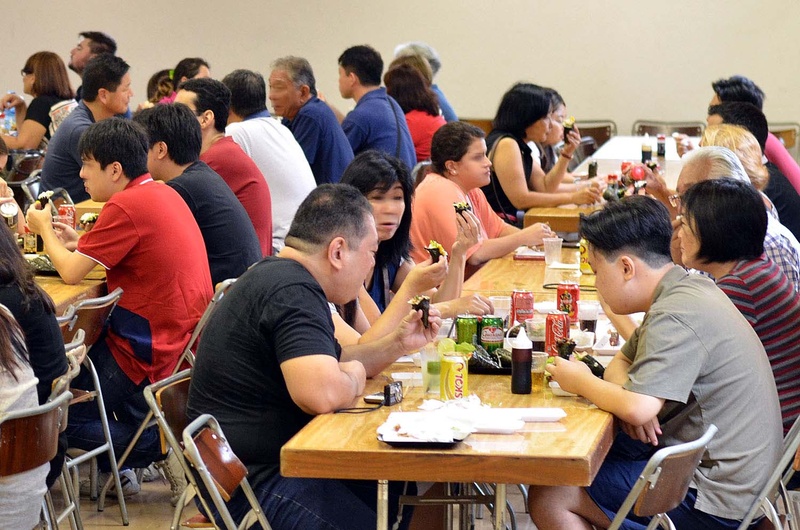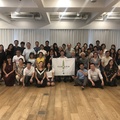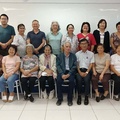From mid-November until just before Christmas, gatherings to celebrate the end of the year take place in Brazil. In general, corporate parties take place earlier; then, the associations and clubs; while friends and family’s are closer to Christmas and New Year, when most people are already on vacation.
In the Nikkei community, these celebrations have a specific name: Bonenkai. The meaning, with minimal adaptation, is “gathering to forget the year.” Of course, the intent behind the expression is of learning from the bad things and being grateful to those with whom any joint work was done during the past year.
Nikkei have the opportunity to participate in many Bonenkai every holiday season. The company’s, family, Kenjinkai, Japanese course, and taiko, karate, dancing, karaoke group…
In the case of companies, Bonenkai usually are held in restaurants and night clubs. In some cases, some of the time is reserved for working matters, such as goals achieved and projects’ progress. However, the greatest intention is a more informal celebration.
The celebrations of Kenjinkai happen most often in the organization’s building. Associates usually take the occasion to talk about the activities completed during the year and to plan for the next year.
The family Bonenkai usually happen in the house of grandparents or older relatives; the friends and other social groups celebrations are organized at the home of a member or at a rented site. Because it is totally informal, some families have the party at Christmas.
Christmas and New Year
Brazil is a country of Catholic tradition. So Christmas is highly valued due to the celebration of the birth of Jesus. There are various rituals, such as preparing supper, the Christmas carols, the nativity scenes, and church ceremonies, among others.
In Brazilian society in general, the Christmas dinner is a very important event, considered the main family reunion of the year. On this day, many families insist that its members come together. On the other hand, the New Year celebration tends to be more related to travel, not necessarily family.
In the Nikkei community, the situation is reversed. Without the observance of so many Catholic rituals, families would celebrate Christmas more modestly, prioritizing the New Year gatherings. These celebrations, however, tend to adapt to local customs.
The menu of these gatherings shows the good mix of cultures that happens in Brazil. Christmas is time for turkey, cod, ham,…and onigiri, harusame, and tempura. Even barbecue is appreciated. For dessert, besides panettone and ice cream (it is summer in Brazil at that time), there is always someone who prefers eating manju or fruits.
In family gatherings, the mochiyori system, in which each person is responsible for bringing a dish, is very common. Up until now, the grandmothers, aunts, and mothers prepare everything. The younger ones bring beverages and dessert.
Among the younger generations, a concern is beginning to emerge: who will continue to organize and prepare these celebrations in the future? Most young Nikkei, especially Sansei and younger generations, have not developed culinary skills comparable to those of the Nisei. The trend has begun that the dishes are purchased or gatherings are held in restaurants. So in the long run, it is possible that the term “bachan food” disappears?
There is also the fact that families are getting smaller. In the generation of Nisei, it is common for a person to have five, six, seven brothers. Consequently, the number of Sansei cousins is very large. In the Sansei generation, the number of brothers decreases too: one or two, rarely passing three. The number of Yonsei cousins tends to be low and so on.
Today, we have a great advantage regarding telecommunications. I have seen Bonenkai happening in real time with relatives in Brazil and Japan via the Internet. With just a few time zone adjustments, relatives were able to talk and exchange vows of good wishes with image and sound.
Secret Santa
Whether with family or friends, people organize “Secret Santas” (in Portuguese, it is “Amigo Secreto,” literally, “Secret Friend”). I do not know if every country has this custom, so I’ll explain quickly. Among a group of people, there is a drawing in which each selects the name of another to give a gift. A meeting is scheduled for the exchange of gifts. Before delivering, one describes his “secret friend” for the others to guess.
It is a conflict of customs. According to Japanese standards, one should not open a gift at the time it is received. However, in a typical Secret Santa in Brazil, one should open the gift and show everyone what it is.
Japanese people in São Paulo
A significant amount of Japanese people currently live in São Paulo. They are mostly employees transferred to work in the Brazilian subsidiaries of Japanese companies.
Some of them come alone, others with family. For them, it is not always possible to return to Japan to spend the end of the year. So, some hotels and restaurants in the Nikkei community organize lunches and dinners especially for this type of situation. Of course, with service in Japanese and typical dishes of that time.
Christmas may represent an inconvenience for some people not accustomed to its traditions. In Brazil, almost all businesses are closed from the afternoon of December 24th and 25th.
A few years ago, I forgot that. Some relatives from the countryside came to visit me, so we decided to eat out. We looked for a restaurant; none were open—even in Liberdade, the district that has a large concentration of Japanese restaurants in São Paulo. We found only one in operation (a subsidiary of a Japanese gyudon network, incidentally). Shortly after, two Japanese families arrived—possibly also unprepared for that Brazilian Christmas routine, since it is not a holiday in Japan.
Ozoni
In celebration of the New Year (Shougatsu), the Nikkei families in Brazil prepare ozoni, which is a rice cake soup. Provincial associations also often hold events accordingly.
This tradition is one of the strongest of this time of year. So much that it can be difficult to find mochi on sale in Japanese food stores in the days before the New Year. Still, there are families and associations that gather to prepare mochi during Bonenkai.
Not everyone really likes ozoni, but all eat it, moved by tradition. With non-descendants, it is a little bit tougher. At first, they are cautious because they don’t know what it is. After it is explained and they are made aware of the tradition, they participate.
Traditional Japanese restaurants serve osechi ryori, which consists of a set of dishes that symbolize prosperity for the coming year.
On the other hand, there are two Japanese traditions with relatively little reflection in the Brazilian Nikkei community: the 108 chimes of the bells of Buddhist temples and sending greeting cards (nengajo). The fact that Brazil is predominantly Catholic and few Buddhist temples exist prevents the tradition of the bells becoming popular. In the case of cards, the message “kotoshi mo yoroshiku onegaishimasu” is embedded in emails and on Christmas cards (real or virtual), or simply spoken the first time that people meet in the new year.
Shinnenkai
After the celebrations of the New Year, it is time for the Shinnenkai, the first gathering of the year. In the Nikkei community of São Paulo, most of the Shinnenkai are organized by Kenjinkai. In terms of quantity, these celebrations happen less in comparison to Bonenkai.
The meeting’s purpose is to plan activities and renew cooperation between people. In some associations, just like in Bonenkai, members prepare mochi, with rice being beaten in a mortar the traditional way.
Traveling
A few years ago, when I was doing an internship in Japan, I attended a “shain ryoko” in January, which is a trip among people who work in a company. Spouses did not participate.
Among Brazilians, personal and professional life is not as polarized as in Japan. Thus, virtually all events that involve some kind of celebration are open to the participation of spouses. This practice extends to the Nikkei community.
Calendar matters
Brazil follows Western traditions and international standards concerning the calendar. Therefore, time is based on Catholic tradition and the Gregorian calendar.
Even in the Nikkei community, it is not common to know the years according to the eras of the Japanese emperors.
Another issue that involves the New Year is the Chinese horoscope. Among the Nikkei community, many know what is the corresponding animal to their birth year, but little else beyond. In Brazil, the most common classification is based on the 12 signs of the zodiac.
In São Paulo, the Chinese community organizes the celebration of Chinese New Year. This is the only time the subject is highlighted in the media, when people will know that 2016 is the Year of the Fire Monkey.
Like so many other Japanese cultural aspects, the end and beginning of year celebrations were adapted within the countries that received immigrants. I believe they have a special meaning for those who came from a country so far away, under difficult conditions, leaving part of their family and their own history.
At these meetings, I often hear from the elders, “good to see the family together.”
© 2016 Henrique Minatogawa






